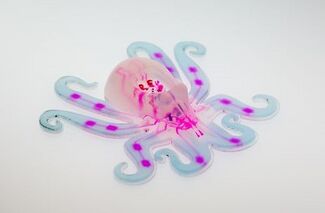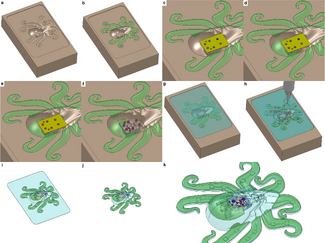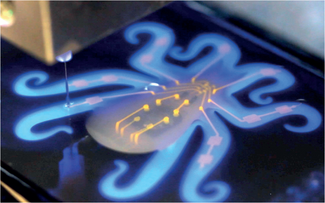3D Printed Microfluidic Robots - Helen Hua

3-D printed microfluidic robots are a recent advancement that combines microfluidic technology and soft robots to create fully soft, autonomous robots, such as the Octobot, shown in Figure 1. [1]
Background

Soft Robots
Robots with rigid bodies are typically made to perform one task efficiently, but cannot adapt to different and new environments. The hard surfaces and rigid joints of the robots create an unsafe environment to interaction with humans.[2]
Soft robots have properties that are difficult to achieve with rigid-bodied robots. The robots can be made from hydrogels, granular media, or elastomers. They are physically resilient and can potentially be able to passively adapt to environment.[1] An example of a soft robot is shown in Figure 2, a manta-ray inspired soft robot.
The technology of robots made of soft materials can produce robots that can adapt to natural environments. With current technology, soft robots are still connected to hard control systems. Producing fully autonomous soft robots presents a great challenge without incorporating rigid, hard systems. [2]
Microfluidic Driven Actuation
In microfluidic devices, actuation can be done using pressure generation. To replace the use of electrical energy and its constraints, pressure generation is a convenient actuation source, creating a pneumatic battery . One approach to create pressure is through a chemical reaction. A chemical reaction that generates gas will increase the pressure within the system and can power the device. [3]
Octobot
The Octobot is a 3-D printed microfluidic robot that is fully autonomous. The robot is made completely of soft materials, such as polydimethylsiloxane (PDMS), Pluronic F127, and SE 1700 and Sylgard 184, which are silicone-based materials. The Octobot is powered by a microfluidic logic controller and a decomposition reaction that generates gas.


Fabrication
Several different techniques are used to produce the Octobot. The body of Soft lithography and micro-moulding and embedded 3-D (EMB3-D) printing. The printing process can be seen in Figure 3.
Micro-molding
The soft controller for the microfluidic logic is made using micro-molding. It is covered with a polyimide mask for protection and placed into a mold filled with hyperelastic layers for actuation. The mold is then filled with the body matrix materials and crosslinked.
EMB3-D Printing
The mesofluidic networks were created by combining micro-moulding and EMB3D printing. A fugative ink was used to pattern the networks, which can be shown in Figure 4.
The fuel reservoirs, reaction chambers, actuation networks, and vent orifics were all EMB3D printed using hydrogel-based inks, fugitive and catalytic.The fugitive ink is compared of a triblock polymer gel and the catalytic pink contains platinum particles in a suspension with Pluronic 127. The properties of these inks were tailored for EMB3D printing [1] and can changed by varying the print speed.
Actuation
The octobot is controlled fully through microfluidic logic, without the need of any hard, rigid control systems. A soft, microfluidic controller sits at the center of the Octobot. The controller regulates fluid flow and the catalytic decomposition of the monopropellant fuel inside the robot.
The microfludic controller is shown in Figure 5. The controller system is divided into four sections: upstream for liquid fuel storage, oscillator for liquid fuel regulation, reaction chamber for the decomposition into pressurized gas, and downstream for gas distribution for actuation and venting.
In the upstream section, the fuel reservoirs are filled using a syringe pump. Backflow into the fuel inlets is prevented using check valves.
The networks downstream from the reaction are inflated from the gas produced from the fuel decomposition. The inflation causes parts of the Octobot to move.
The power source of the robot is the decomposition of aqueous hydrogen peroxide, shown in the reaction below.
2H2O2 (l) → 2H2O (l,g) + O2 (g).
The reaction results in a 240-fold volumetric expansion.
The controller is designed to operate at fuel flow rates of 40 μl min-1, with a fuel capacity of 1 ml, resulting in a theoretical run time of 12.5 minutes.[1]
-
Video: Movement of tentacles of octopod, soft robotics.
References
- ↑ 1.0 1.1 1.2 1.3 1.4 1.5 1.6 Wehner, M.; Truby, R. L.; Fitzgerald, D. J.; Mosadegh, B.; Whitesides, G. M.; Lewis, J. A.; Wood, R. An integrated design and fabrication strategy for entirely soft, autonomous robots J. Nature. 2016, 536 (7617), 451–455. DOI: 10.1038/nature19100
- ↑ 2.0 2.1 2.2 Rus, D.; Tolley, M. T. Design, fabrication and control of soft robots. Nature 2015, 521 (7553), 467–475. DOI: 10.1038/nature14543
- ↑ Onal, C. D., Chen, X., Whitesides, G. M. & Rus, D. Soft mobile robots with on-board chemical pressure generation. In 15th International Symposium on Robotics Research (ISRR 2011) 1–16 (2011) DOI:10.1007/978-3-319-29363-9_30.
